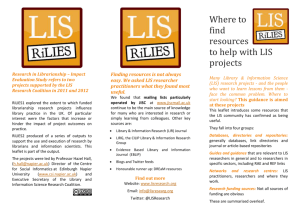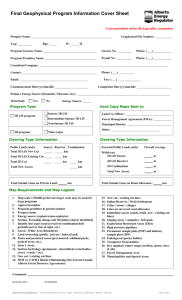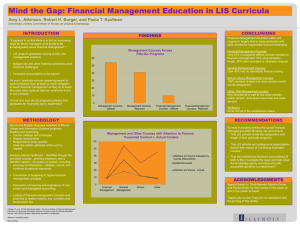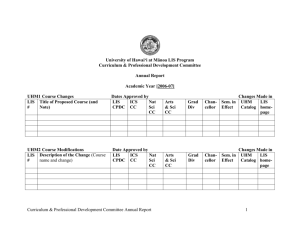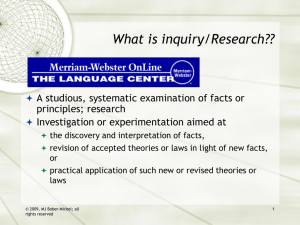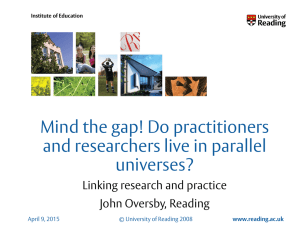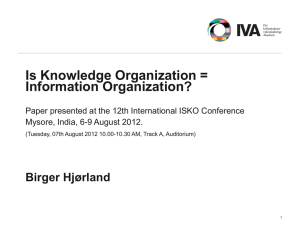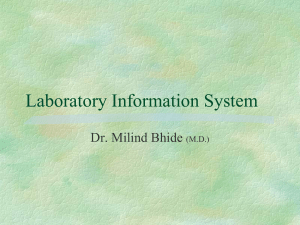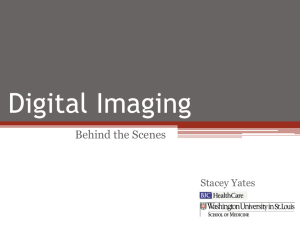Planning Impactful LIS Projects: A Guide
advertisement
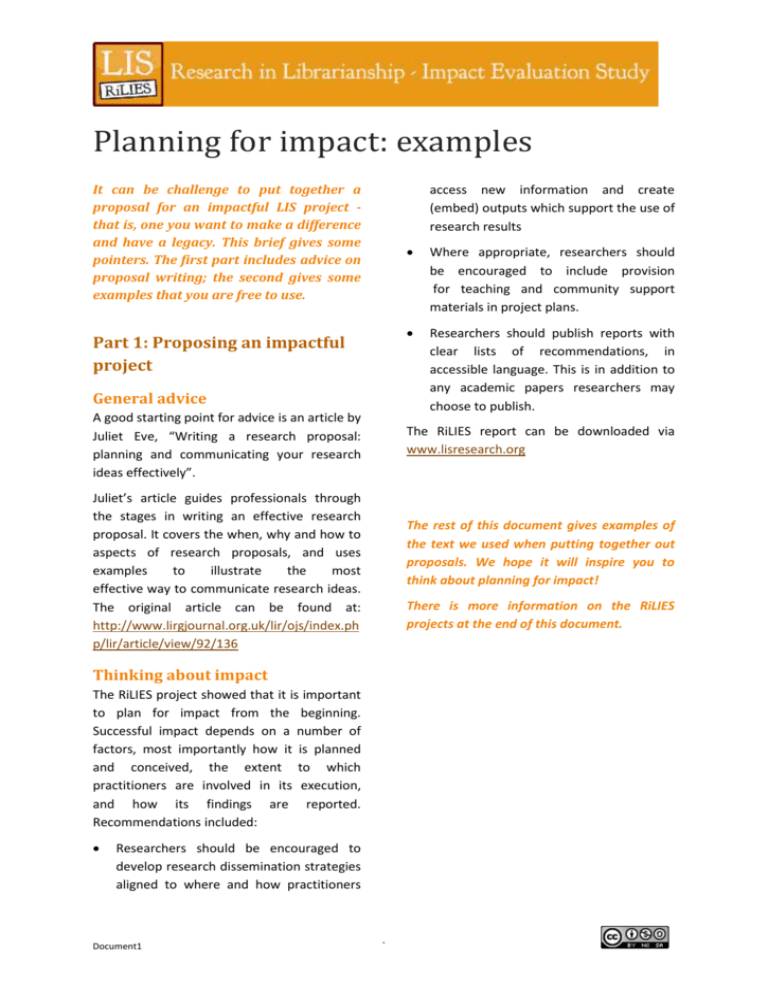
Planning for impact: examples It can be challenge to put together a proposal for an impactful LIS project that is, one you want to make a difference and have a legacy. This brief gives some pointers. The first part includes advice on proposal writing; the second gives some examples that you are free to use. access new information and create (embed) outputs which support the use of research results Part 1: Proposing an impactful project General advice A good starting point for advice is an article by Juliet Eve, “Writing a research proposal: planning and communicating your research ideas effectively”. Researchers should publish reports with clear lists of recommendations, in accessible language. This is in addition to any academic papers researchers may choose to publish. The rest of this document gives examples of the text we used when putting together out proposals. We hope it will inspire you to think about planning for impact! There is more information on the RiLIES projects at the end of this document. Thinking about impact The RiLIES project showed that it is important to plan for impact from the beginning. Successful impact depends on a number of factors, most importantly how it is planned and conceived, the extent to which practitioners are involved in its execution, and how its findings are reported. Recommendations included: Researchers should be encouraged to develop research dissemination strategies aligned to where and how practitioners Document1 Where appropriate, researchers should be encouraged to include provision for teaching and community support materials in project plans. The RiLIES report can be downloaded via www.lisresearch.org Juliet’s article guides professionals through the stages in writing an effective research proposal. It covers the when, why and how to aspects of research proposals, and uses examples to illustrate the most effective way to communicate research ideas. The original article can be found at: http://www.lirgjournal.org.uk/lir/ojs/index.ph p/lir/article/view/92/136 ` Planning for impact: examples Part 2: Example texts DREaM Project This section gives an example Impact Summary from the DREaM project proposal. Although the content is specific to the particular project, it is worth reading and should be a useful resource when writing other proposals. Key features are: Clarity about audience and how it will be reached Specific examples of envisaged impact It demonstrates previous successes by project participants It proposes approaches to measuring impact It is realistic about limitations The main beneficiaries from the project will be academic LIS researchers (including research fellows and doctoral students) and practitioner researchers, both experienced and inexperienced. They will be exposed to a new range of skills and contacts that they can use in their work. Given the structure of the project, it is these direct beneficiaries who will first experience the positive outcomes of the project. Library end-users across all sectors are indirect beneficiaries of the project. In short, they will benefit from improvements in library and information services provision that result from changes made on the basis of a sound evidence base derived from research output. Equally, those responsible for policy making will be able to draw on the new resources that are generated by the larger pool of skilled LIS researchers. So, for example, DCMS will have access to an evidence base for decisions on public library services provision, and the AHRC will have a clearer picture of where LIS research priorities lie with reference to its broad research agenda. It is also possible to argue that society at large benefits from a project of this nature in that targeted effort that goes into supporting key public services, such as public libraries, enhances the environment in which we work and live. There are therefore potential benefits to the quality of life of ordinary citizens. In the future it may be possible to tie specific positive outcomes back to research projects, the seeds of which were sown at one of the DREAM events. Involvement of international participants in the programme gives an opportunity to strengthen links with LIS research colleagues beyond the UK, and demonstrate an excellence in the UK's commitment to LIS research. It will be possible to measure some of the project outcomes within the timeframe of the project itself. For example, it will be relatively straightforward to assess the perceptions of the extent of growth in research skills amongst practitioner researcher participants at DREAM events. The value of other outcomes will become evident at a later date. For example, if the project is successful in fostering a research culture amongst LIS practitioners, it is reasonable to expect to see a larger proportion of journal submissions by this constituency. However, given the time lag between accessing resources to start a research project and the approval of a paper for publication, it is unlikely that this will be seen within the 20 month time-frame of the DREAM project. To ensure the project and its outcomes has as wide an impact as possible, arrangements have been made to use multiple channels for both the coordination of activities and the dissemination of results. The project itself will 2 of 4 Planning for impact: examples have an online presence that will offer more than a standard repository for project material. For example, it will include a Ning to foster collaboration online, and podcast and videocast material from the workshops will be accessible from the site. Hazel Hall has experience of managing online environments such as this for collaborative work purposes and is therefore positioned to capitalise on the investment made in the online resource. More traditional project outputs have been identified, such as journal articles and conference papers. Depending on the materials gathered in the course of the project some material may be suitable for publication in book form. RiLIES proposal extracts This adapted extract from our proposal shows a different approach to achieving the same ends. One of the main lessons of the RiLIES Project (Hall, Cruickshank & Taylor-Smith (2012)) is that researchers need to engage with the target audience of their eventual research output from the very early stages to achieve impact, for example by involving practitioners in project definition and research design. <Proposed project> will ensure that this theme is addressed as part of the project. It is imperative that outputs be formulated in such a way that they are attractive to the target community. This comprises practitioners, practitioner researchers, […], consultants and funders. Engagement from these parties will ensure that the investment in the work is realised, with its impact felt by both LIS practitioners and, in turn, by the communities that they serve. The project will achieve impact through four main activities: 1. The identification of existing resources and good practice in the community … This scoping exercise will determine gaps in provision in existing training, good practice and community materials. It will ensure that RiLIES2 focuses on where there is a need for the development of new materials, and guard against duplication of effort. 2. The development of a series of training and good practice materials (i.e. a toolkit) [...]. The training and good practice materials will be developed taking into account the findings of activity 1 above. These are likely to include: (list of example materials such as pages on an existing website, quick reference guides on particular topics, PowerPoint presentations for trainers (consultants, managers, professional bodies), posters) 3. The identification and development of community space: It will be necessary to find a “home” where the training and good practice materials can be hosted, and around which an engaged community may be sustained and grow in the longer term. (Ideally the development of identified existing provision). This work will be done in parallel with an engagement plan that takes into account hard-to-reach (mainly public) librarians. 4. Materials launch: The materials will be launched in (period, with proposed events). Cont’d over/... 3 of 4 Planning for impact: examples Stakeholders and dissemination strategy Stakeholders who will benefit from the study include: [List of stakeholders] Outputs will be tailored to the needs of these specific audiences, as appropriate. News about the project will be disseminated throughout its duration. Members of the project team are already committed to involvement in a number of events at which there will be opportunities to publicise the project face-to-face. They will make efforts to take advantage of participation at these events to spread the word of the work, in the light of findings that identified faceto-face dissemination as the LIS practitioners’ preferred route to research output. Schedule of events Related projects and activities that could be used for spreading the word can be identified and included, for instance in a table as below. It helps make the planned activity clear, and also helps focus on concrete activities. Date (launch) Event Comments/motivation News of the project launch to be presented in opening session at XXX event. News of the project will be spread informally through networking at the conference in XXX (during project) (Community engagement) It is hoped that plans to embed the project output in the community ... to include approval of the proposed training event at which the project outputs will be launched Workshop session will be used to generate feedback on draft materials, and may include input from the community on their final design (results) Final opportunity to provide face-toface updates on the project prior to its conclusion at the end of the month As well as taking advantage of these opportunities to relay information to the community at large in person, the existing infrastructure – such as the Twitter feed, the web site, and the established good will of the community – will be used to support dissemination. References Cruickshank, P., Hall, H., Taylor-Smith, E. (2012). Enhancing the impact of LIS Research Projects. Research Information Network (RIN). Eve, J. (2008). “Writing a research proposal: planning and communicating your research ideas effectively” in Library and Information Research journal. Volume 32, Number 102. The RiLIES projects Research in Librarianship – Impact Evaluation Study (RiLIES) refers to two projects supported by the LIS Research Coalition in 2011 and 2012. RiLIES1 explored the extent to which funded librarianship research projects influence library practice in the UK. Of particular interest were the factors that increase or hinder the impact of project outcomes on practice. RiLIES2 produced of a series of outputs to support the use and execution of research by librarians and information scientists. The projects were led by Professor Hazel Hall, (h.hall@napier.ac.uk) Director of the Centre for Social Informatics at Edinburgh Napier University (www.csi.napier.ac.uk) and Executive Secretary of the Library and Information Science Research Coalition. 4 of 4

